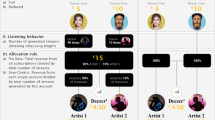Abstract
Record labels and telecoms are using the pervasiveness of mobile technologies to create a mobile music market, where customers can have their preferred music at any time and in any place. The idea is to replicate the successful strategy of the Internet-based music market into the mobile scenario. In this paper we first analyze the current mobile music market and we show that this strategy leads to several problems (e.g., excessive download time, cost and protection). As a second contribution, we propose and analyze a multi-channel distribution strategy, where customers can cooperate to music distribution. The approach is based on the cellphone network, the free-of-charge communication technologies provided by cellphones, and on an incentive mechanism that financially compensates users for their cooperation in music distribution. The approach evaluation shows that the employment of an effective incentive mechanism can mitigate the problems of the current mobile music scenario, as it provides benefits to customers, cellphone network providers and music stores.
Similar content being viewed by others
References
Almeroth KC, Garyfalos A (2004) Coupons: wide scale information distribution for wireless ad hoc networks. In: Proc of IEEE Globecom, December
Anagnostakis KG, Greenwald MB (2004) Exchange-based incentive mechanisms for peer-to-peer file sharing. In: International conference on distributed computing systems
Anagnostakis KG, Yang MBG, Condie T, Kamvar S, Garcia-Molina H (2004) Non-cooperation in competitive p2p networks. In: International conference on distributed computing systems
Antoniadis P, Courcoubetis C, Strulo B (2005) Incentives for content availability in memory-less peer-to-peer file sharing systems. SIGecom Exch 5(4):11–20, ACM press.
Biddle K, England P, Peinado M, Willman B (2002) The darknet and the future of content distribution. In: Proc. of the ACM workshop on DRM
Brown B, Sellen AJ, Geelhoed E (2001) Music sharing as a computer supported collaborative application. In: Proceedings of ECSCW 2001, Bohn, Germany, 2001. Kluwer
Buttyan L, Hubaux JP (2003) Stimulating cooperation in selforganizing mobile ad hoc networks. J Spec Top Mob Netw Appl 8(5):579–592, October
Cobb CJ, Hoyer WD (1986) Planned versus impulse purchase behavior. J Retailing 62:384–409, April
Dingledine R, Syverson P (2002) Reliable mix cascade networks through reputation. In: Proceedings of the sixth international financial cryptography conference (FC02), March
Feldman M, Lai K, Stoica I, Chuang J (2004) Robust incentive techniques for peer-to-peer networks. Proceedings of the 5th ACM conference on electronic commerce, pp 102-111
Harjula E, Ylianttila M, Ala-Kurikka J, Riekki J, Sauvola J (2004) Plug-and-play application platform: towards mobile peer-to-peer. Proceedings of the 3rd international conference on mobile and ubiquitous multimedia MUM, October
Hatt N (2005) BlueFramework—application framework for bluetooth enabled mobile phones, TIK-MA-2005-16, ETH Zürich, Switzerland
Hu TH-T, Wongrujira K, Seneviratne A (2004) Reputation in peer-to-peer networks. In: Proceedings of the IEEE international conference on communications (ICC 2004), Paris, France, pp 1411–1415, June
Hughes D, Coulson G, Walkerdine J (2005) Free riding on gnutella revisited: the bell tolls? IEEE Dist Syst online 6(6):1, June
IFIP (2006) The digital music report 2006—facts and figures. Research report, International Federation of the Phonographic Industry. Available at http://www.ifpi.org/site-content/press/20060119d.html
Khelil A, Becker C, Tian J, Rothermel K (2002) An epidemic model for information diffusion in MANETs. Proceedings of the 5th ACM international workshop on modeling, analysis and simulation of wireless and mobile systems, September
Liang J, Kumar R, Xi Y, Ross K (2005) Pollution in P2P file sharing systems. In: IEEE Infocom, Miami, FL, USA, March
Messerges TS, Dabbish EA (2003) Digital rights management in a 3G mobile phone and beyond proceedings of digital right management (DRM). ACM Press, Washington, October
Microsoft Corporation (2007) Microsoft PlayReady powers next-generation media experiences on mobile networks, http://www.microsoft.com/presspass/press/2007/feb07/02-123GSMNewTechnologyPR.mspx
O’Grady MJ, O’Hare GMP (2004) Just-in-time multimedia distribution in a mobile computing environment. IEEE Multimedia, pp 62–74
Premkumar GP (2003) Alternative distribution strategies for digital music. Commun ACM 9(9):89–95, September
Resnick P, Kuwabara K, Zeckhauser R, Friedman E (2000) Reputation systems. Commun ACM 43(12):45–48
Roczniak A, El Saddik A (2005) Impact of incentive mechanisms on quality of experience. Proceedings of the 13th annual ACM international conference on multimedia, pp 311–314
Rook D (1987) The buying impulse. J Consumer Res 14(2):189–199, September
Salem NB, Buttyan MJL, Hubaux JP (2003) A charging and rewarding scheme for packet forwarding. In: Proceedings of MobiHoc, June
Sun Q, Garcia-Molina H (2004) Slic: A selfish link based incentive mechanism for unstructured peer-to-peer networks. In: International conference on distributed computing systems
Tennent P, Hall M, Brown B, Chalmers M, Sherwood S (2005) Toward social mobility: three applications for mobile epidemic algorithms. Proceedings of the 7th international conference on Human computer interaction with mobile devices & services MobileHCI ’05
Wireless-Intelligence (2005) World cellular connection. Research report, Wireless Intelligence, 2005. Available at https://www.wirelessintelligence.com
Author information
Authors and Affiliations
Corresponding author
Additional information
A preliminary version of this work appeared in the Proceedings of IEEE International AXMEDIS Conference 2006.
Rights and permissions
About this article
Cite this article
Furini, M., Montangero, M. The impact of incentive mechanisms in multi-channel mobile music distribution. Multimed Tools Appl 37, 365–382 (2008). https://doi.org/10.1007/s11042-007-0158-z
Published:
Issue Date:
DOI: https://doi.org/10.1007/s11042-007-0158-z




